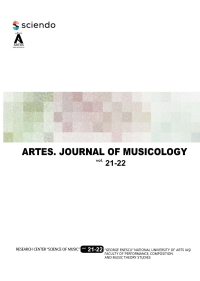Enescu’s Musical Language in Suite Impresii din copilărie [Impressions of Childhood]
DOI:
https://doi.org/10.35218/Keywords:
melody, rhythm, harmony, heterophony, tonalityAbstract
The musical language of George Enescu (1881-1955) is sprinkled with symbolic valences that carry the imprint of the Romanian musical culture. For more than half of a century (57 years), Enescu wrote musical works inspired by the folkloric tradition. Between the Romanian Poem, written when he was 16 (in 1897) and the Chamber Symphony, when he was 73 (in 1954), Enescu also composed: Romanian Rhapsody No. 1 (A major), op. 11 (in 1901), Romanian Rhapsody No. 2 (D major), op. 11 (in 1902), Sonata for piano and violin No. 3, A minor (in 1926), Caprice Roumain, for violin and orchestra (in 1928), Orchestral Suite No. 3 (From the country), op. 27, D major (in 1938) and the programmatic suite Impresii din copilărie [Impressions of Childhood for violin and piano], op. 28 in D major (composed in 1940). The paper presents the temporal-spatial structure of the musical masterpiece which reveals a cyclical thinking based on a presentation of the exterior images, followed by the interior images and a return to the exterior. And by an extrapolation of meanings, I created an analogy with the stages of life: childhood, maturity and old age. This article also deals with elements of the musical language used by George Enescu in a manner that reveals a re-created Romanian folklore in a way which bears the imprint of personality and originality of the composer.
Downloads
Published
Issue
Section
License
Copyright (c) 2023 ARTES. JOURNAL OF MUSICOLOGY

This work is licensed under a Creative Commons Attribution-NonCommercial 4.0 International License.

